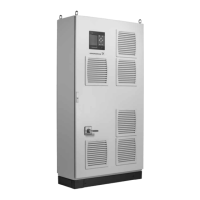24
11.6.2 Current alarms (3.1)
Fig. 29 Current alarms
Description
This submenu shows the following:
• Warnings caused by faults that still exist.
• Warnings caused by faults that have disappeared, but the
warning requires manual reset.
• Alarms caused by faults that still exist.
• Alarms caused by faults that have disappeared, but the
alarm requires manual reset.
All warnings and alarms with automatic reset are automatically
removed from the menu when the fault has disappeared.
Alarms requiring manual reset are reset in this display by
pressing . An alarm cannot be reset until the fault has
disappeared.
For every warning or alarm, the following will be shown:
• Whether it is a warning or an alarm .
• Where the fault occurred: System, Pump 1, Pump 2, etc.
• In case of input-related faults, the input will be shown.
• What the cause of the fault is, and the alarm code in brackets:
Water shortage (214), Max. pressure (210), etc.
• When the fault occurred: Date and time.
• When the fault disappeared: Date and time. If the fault still
exists, date and time are shown as --...--.
The latest warning/alarm is shown at the top of the display.
11.6.3 Alarm log (3.2)
The alarm log can store up to 24 warnings and alarms.
Fig. 30 Alarm log
Description
Here warnings and alarms are shown.
For every warning or alarm, the following will be shown:
• Whether it is a warning or an alarm .
• Where the fault occurred. System, Pump 1, Pump 2, etc.
• In case of input-related faults, the input will be shown.
• What the cause of the fault is, and the alarm code in brackets:
Water shortage (214), Max. pressure (210), etc.
• When the fault occurred: Date and time.
• When the fault disappeared: Date and time. If the fault still
exists, date and time are shown as --...--.
The latest warning/alarm is shown at the top of the display.
TM03 2293 4607
TM03 2292 4807

